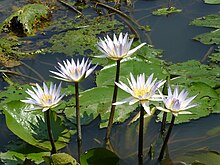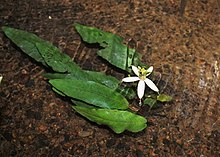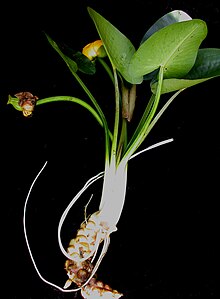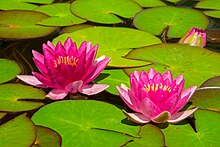This article may be too technical for most readers to understand. (May 2021) |
| Nymphaeaceae Temporal range:
Early Cretaceous - Recent
| |
|---|---|

| |
| Nymphaea nouchali | |
|
Scientific classification
| |
| Kingdom: | Plantae |
| Clade: | Tracheophytes |
| Clade: | Angiosperms |
| Order: | Nymphaeales |
| Family: |
Nymphaeaceae Salisb. [1] |
| Genera | |
|
Extant genera [2] Fossil genera
| |
| Synonyms [3] | |
| |




Nymphaeaceae ( /ˌnɪmfiˈeɪsi.iː, -ˌaɪ/) is a family of flowering plants, commonly called water lilies. They live as rhizomatous aquatic herbs in temperate and tropical climates around the world. The family contains five genera [4] with about 70 known species. [5] Water lilies are rooted in soil in bodies of water, with leaves and flowers floating on or emergent from the surface. Leaves are round, with a radial notch in Nymphaea and Nuphar, but fully circular in Victoria and Euryale.
Water lilies are a well-studied clade of plants because their large flowers with multiple unspecialized parts were initially considered to represent the floral pattern of the earliest flowering plants, and later genetic studies confirmed their evolutionary position as basal angiosperms. Analyses of floral morphology and molecular characteristics and comparisons with a sister taxon, the family Cabombaceae, indicate, however, that the flowers of extant water lilies with the most floral parts are more derived than the genera with fewer floral parts.[ clarification needed] Genera with more floral parts, Nuphar, Nymphaea, Victoria, have a beetle pollination syndrome, while genera with fewer parts are pollinated by flies or bees, or are self- or wind-pollinated. [6] Thus, the large number of relatively unspecialized floral organs in the Nymphaeaceae is not an ancestral condition for the clade.
Description
The Nymphaeaceae are aquatic, rhizomatous herbs. [7] The family is further characterized by scattered vascular bundles in the stems, and frequent presence of latex, usually with distinct, stellate-branched sclereids projecting into the air canals. Hairs are simple, usually producing mucilage (slime).
Leaves are alternate and spiral, opposite or occasionally whorled, simple, peltate or nearly so, entire to toothed or dissected, short to long petiolate, with blade submerged, floating or emergent, with palmate to pinnate venation. [7] Stipules are either present or absent. Surface leaves are absent during winter, and therefore the gases in the rhizome lacunae access equilibrium with the gases of the sediment water.[ citation needed] The leftover of internal pressure is embodied by the constant streams of bubbles that outbreak when rising leaves are ruptured in the spring.[ citation needed][ clarification needed]
Flowers
Flowers are solitary, bisexual, radial, with a long pedicel and usually floating or raised above the surface of the water, with girdling vascular bundles in receptacle. [8] [9] Some species are protogynous and primarily cross-pollinated, but because male and female stages overlap during the second day of flowering, and because it is self-compatible, self-fertilization is possible. [10] Female and male parts of the flower are usually active at different times, to facilitate cross-pollination, although this is just one of several reproductive strategies used by these plants. [11]
There are 4–12 sepals, which are distinct to connate, imbricate, and often petallike. Petals lacking or 8 to numerous, inconspicuous to showy, often intergrading with stamens. Stamens are 3 to numerous, the innermost sometimes represented by staminodes. Filaments are distinct, free or adnate to petaloid staminodes, slender and well differentiated from anthers to laminar and poorly differentiated from anthers; pollen grains usually monosulcate or lacking apertures. Carpels are 3 to numerous, distinct or connate.[ citation needed]
Fruit
The fruit is an aggregate of nuts, a berry, or an irregularly dehiscent fleshy spongy capsule. [7] Seeds are often arillate, more or less lacking endosperm.
Taxonomy

Nymphaeaceae has been investigated systematically for decades because botanists considered their floral morphology to represent one of the earliest groups of angiosperms. [6] Modern genetic analyses by the Angiosperm Phylogeny Group researchers has confirmed its basal position among flowering plants. [1] [12] [13] [14] In addition, the Nymphaeaceae are more genetically diverse and geographically dispersed than other basal angiosperms. [15] [16] Nymphaeaceae is placed in the order Nymphaeales, which is the second diverging group of angiosperms after Amborella in the most widely accepted flowering plant classification system, APG IV system. [12] [13] [14]
Nymphaeaceae is a small family of three to six genera: Barclaya, Euryale, Nuphar, Nymphaea, Ondinea, and Victoria. The genus Barclaya is sometimes given rank as its own family, Barclayaceae, on the basis of an extended perianth tube (combined sepals and petals) arising from the top of the ovary and by stamens that are joined in the base. However, molecular phylogenetic work includes it in Nymphaeaceae. [17] The genus Ondinea has recently been shown to be a morphologically aberrant species of Nymphaea, and is now included in this genus. [18] The genera Euryale, of far east Asia, and Victoria, from South America, are closely related despite their geographic distance, but their relationship toward Nymphaea need further studies. [19] [20] [21]
The sacred lotus was once thought to be a water lily, but is now recognized to be a highly modified eudicot in its own family Nelumbonaceae of the order Proteales.
Fossils
Several fossil species are known, including Cretaceous representatives of Nymphaea, as well as fossil genera such as Jaguariba from the Cretaceous of Brazil, Allenbya from the Ypresian of British Columbia, [22] Notonuphar from the Eocene of Antarctica, [23] [24] Nuphaea from the Eocene of Germany, [25] and Susiea from the Late Paleocene Almont Flora of North Dakota, USA. [26]
As an invasive species
The beautiful nature of water lilies has led to their widespread use as ornamental plants. The Mexican waterlily, native to the Gulf Coast of North America, is planted throughout the continent. It has escaped from cultivation and become invasive in some areas, such as California's San Joaquin Valley. It can infest slow-moving bodies of water and is difficult to eradicate. Populations can be controlled by cutting top growth. Herbicides can also be used to control populations using glyphosate and fluridone. [27]
Culture
The water lily is the national flower of Iran, Bangladesh and Sri Lanka. The Emblem of Bangladesh contains a lily floating on water. It is also the birth flower for the month of July.
The Nymphaeaceae, which is also called (Nilufar Abi in Persian), can be seen in many reliefs of the Achaemenid period (552 BC) such as the statue of Anahita in the Persepolis. Lotus flower was included in Kaveh the blacksmith's Derafsh and later as the flag of the Sasanian Empire Derafsh Kaviani. Today, it is known as the symbol of Iranians Solar Hijri Calendar.
Lily pads, also known as Seeblätter, are a charge in Northern European heraldry, often coloured red ( gules), and appear on the flag of Friesland and the coat of arms of Denmark (in the latter case often replaced by red hearts).
The water lily has a special place in Sangam literature and Tamil poetics, where it is considered symbolic of the grief of separation; it is considered to evoke imagery of the sunset, the seashore, and the shark.
Heraldry
-
Personal coat of arms of Cyril Newall, 1st Baron Newall (1946)
-
National Emblem of Bangladesh (1972–present)
-
Coat of arms of Montederramo, Ourense.
In visual arts
Water lilies were depicted by the French artist Claude Monet (1840–1926) in a series of paintings.
The Maya

The main job of the Maya rulers during pre-Columbian Mesoamerica was to obtain clean and drinkable water for their citizens during both the wet and dry seasons. Their success in accomplishing this is what allowed them to grow their polity by attracting dry-season laborers. They did this by constructing water systems such as reservoirs, wetland reclamation, and dams and channels to capture and store rainwater. With their knowledge of the wetland biosphere, they transformed artificial reservoirs into wetland biospheres. One way that they tested whether the water systems were working properly was if the Nymphaeaceae were thriving. Water lilies became a visual sign of water cleanliness, so the Maya elite began to associate themselves with the flowers. [28]
The Maya began to use water lily iconography depicted on stelae, monumental architecture, murals, and in hieroglyphic writing. [29] Even in Maya settlements like Palenque, where the main water supplies were springs and flowing streams (places water lilies can not grow), the flowers were prevalent in their iconographic records. Aristocrats and religious figures wore masks and/or headdresses during celebratory events that had water lilies and/or water lily symbols to appear like gods. [30] There is also evidence that water lilies were used as cultural entheogenic. Some interpretations of ritual scenes drawn out by the Maya have been blood being extracted from perforated body parts. However, more close examinations show that this is instead a liquid flowing directly from water lily flowers that were on the heads of certain gods. [30] It is likely that the Maya ingested these plants to create a non-ordinary state of consciousness, which makes sense because there is a class of opiate alkaloids in Nymphaeaceae. [30] Overall, these examples show just how important this specific form of water symbolism was throughout the Maya region. [31]
Gallery
-
Lily pads floating in a lake in Toronto, Canada
-
Lily pads floating on Matkusjoki River in Iisalmi, Finland
-
Water lily at Sambalpur
-
Water Lilies, 1920-1926, Musée de l'Orangerie
-
Nuphar pumila 2014 in China
-
Time-lapse video of a water lily blooming
-
Water lily blooming in Sankarpur of West Bengal
-
Blue water lily of Bangladesh
-
Yellow water lilies in Wales, 2021
See also
- Nelumbo
- Pamplemousses Botanical Garden, famous for its giant water lilies
- List of plants known as lily
References
- ^ a b Angiosperm Phylogeny Group (2009), "An update of the Angiosperm Phylogeny Group classification for the orders and families of flowering plants: APG III", Botanical Journal of the Linnean Society, 161 (2): 105–121, doi: 10.1111/j.1095-8339.2009.00996.x, hdl: 10654/18083
- ^ "Nymphaeaceae Salisb". Plants of the World Online. Royal Botanic Gardens, Kew. Retrieved 22 July 2023.
- ^ Nymphaeaceae. (n.d.). GBIF | Global Biodiversity Information Facility. Retrieved August 4, 2023, from https://www.gbif.org/species/103019924
- ^ "Nymphaeaceae Salisb. Ann. Bot. (König & Sims) 2: 70. 1805. (Jun 1805)". World Flora Online. The World Flora Online Consortium. 2022. Retrieved 13 July 2022.
- ^ Christenhusz, M. J. M. & Byng, J. W. (2016). "The number of known plants species in the world and its annual increase". Phytotaxa. 261 (3): 201–217. doi: 10.11646/phytotaxa.261.3.1.
- ^ a b Phylogeny, Classification and Floral Evolution of Water Lilies (Nymphaeaceae; Nymphaeales): A Synthesis of Non-molecular, rbcL, matK, and 18S rDNA Data, Donald H. Les, Edward L. Schneider, Donald J. Padgett, Pamela S. Soltis, Douglas E. Soltis and Michael Zanis, Systematic Botany, Vol. 24, No. 1, 1999, pp. 28-46
- ^ a b c "Family: Nymphaeaceae (water-lily family): Go Botany". gobotany.nativeplanttrust.org. Retrieved 2021-05-07.
- ^ Ito, Motomi (1986). "Studies in the floral morphology and anatomy of nymphaeales". The Botanical Magazine Tokyo. 99 (2): 169–184. doi: 10.1007/bf02488818. ISSN 0006-808X. S2CID 2037133.
- ^ Supaphon, Preuttiporn; Keawpiboon, Chutima; Preedanon, Sita; Phongpaichit, Souwalak; Rukachaisirikul, Vatcharin (2018). "Isolation and antimicrobial activities of fungi derived from Nymphaea lotus and Nymphaea stellata". Mycoscience. 59 (5): 415–423. doi: 10.1016/j.myc.2018.02.012. ISSN 1340-3540. S2CID 89844294.
- ^ Ervik, F.; Renner, S.S.; Johanson, K.A. (1995). "Breeding system and pollination of Nuphar luteum (L.) Smith (Nymphaeaceae) in Norway". Flora. 190 (2): 109–113. doi: 10.1016/s0367-2530(17)30639-4. ISSN 0367-2530.
- ^ Wiersema, John H. (1988). "Reproductive Biology of Nymphaea (Nymphaeaceae)". Annals of the Missouri Botanical Garden. 75 (3): 795–804. doi: 10.2307/2399367. JSTOR 2399367.
- ^ a b Angiosperm Phylogeny Group (2016). "An update of the Angiosperm Phylogeny Group classification for the orders and families of flowering plants: APG IV". Botanical Journal of the Linnean Society. 181 (1): 1–20. doi: 10.1111/boj.12385. ISSN 0024-4074.
- ^ a b As easy as APG III - Scientists revise the system of classifying flowering plants, The Linnean Society of London, 2009-10-08, retrieved 2009-10-29
- ^ a b APG III tidies up plant family tree, Horticulture Week, 2009-10-08, retrieved 2009-10-29
- ^ Mario Coiro & Maria Rosaria Barone Lumaga (2013): Aperture evolution in Nymphaeaceae: insights from a micromorphological and ultrastructural investigation, Grana, DOI:10.1080/00173134.2013.769626
- ^ Insights into the dynamics of genome size and chromosome evolution in the early diverging angiosperm lineage Nymphaeales (water lilies), Jaume Pellicer, Laura J Kelly, Carlos Magdalena, Ilia Leitch, 2013, Genome, 10.1139/gen-2013-0039
- ^ Les DH, Schneider EL, Padgett DJ, Soltis PS, Soltis DE, Zanis M (1999) Phylogeny, classification and floral evolution of water lilies (Nymphaeaceae; Nymphaeales): a synthesis of non-molecular, rbcL, matK, and 18S rDNA data. Systematic Botany 24: 28–46.
- ^ Löhne C, Wiersema JH, Borsch T (2009) The unusual Ondinea, actually just another Australian water-lily of Nymphaea subg. Anecphya (Nymphaeaceae). Willdenowia 39: 55–58.
- ^ Löhne C, Borsch T, Wiersema JH (2007) Phylogenetic analysis of Nymphaeales using fast-evolving and noncoding chloroplast markers. Botanical Journal of the Linnean Society 154: 141–163.
- ^ Borsch T, Löhne C, Wiersema J (2008) Phylogeny and evolutionary patterns in Nymphaeales: integrating genes, genomes and morphology. Taxon 57: 1052–1081.
- ^ Dkhar J, Kumaria S, Rama Rao S, Tandon P (2012) Sequence characteristics and phylogenetic implications of the nrDNA internal transcribed spacers (ITS) in the genus Nymphaea with focus on some Indian representatives. Plant Systematics and Evolution 298: 93–108.
- ^ Cevallos-Ferriz, S. R.; Stockey, R. A. (1989). "Permineralized fruits and seeds from the Princeton chert (Middle Eocene) of British Columbia: Nymphaeaceae". Botanical Gazette. 150 (2): 207–217. doi: 10.1086/337765. S2CID 86651676.
- ^ Taylor, David Winship; Gee, Carole T. (1 October 2014). "Phylogenetic Analysis of Fossil Water Lilies Based on Leaf Architecture and Vegetative Characters: Testing Phylogenetic Hypotheses from Molecular Studies". Bulletin of the Peabody Museum of Natural History. 55 (2): 89–110. doi: 10.3374/014.055.0208. ISSN 0079-032X. S2CID 84253809.
- ^ Friis, Else M.; Iglesias, Ari; Reguero, Marcelo A.; Mörs, Thomas (2017-08-01). "Notonuphar antarctica, an extinct water lily (Nymphaeales) from the Eocene of Antarctica". Plant Systematics and Evolution. 303 (7): 969–980. Bibcode: 2017PSyEv.303..969F. doi: 10.1007/s00606-017-1422-y. ISSN 2199-6881. S2CID 23846066.
- ^ Gee, C. T., & Taylor, D. W. (2019). "An Extinct Transitional Leaf Genus of Nymphaeaceae from the Eocene Lake at Messel, Germany: Nuphaea engelhardtii Gee et David W. Taylor gen. et sp. nov." International Journal of Plant Sciences, 180(7), 724-736.
- ^ Taylor, W., DeVore, M. L., & Pigg, K. B. (2006). "Susiea newsalemae gen. et sp. nov.(Nymphaeaceae): Euryale-like seeds from the Late Paleocene Almont Flora, North Dakota, USA." International Journal of Plant Sciences, 167(6), 1271-1278.
- ^ "Nyphaea genus". www.cdfa.ca.gov. Retrieved 2018-09-13.
- ^ Lucero, Lisa J.; Gunn, Joel D.; Scarborough, Vernon L. (1 April 2011). "Climate Change and Classic Maya Water Management". Water. 3 (2): 479–94. doi: 10.3390/w3020479.
- ^ Puleston, Dennis E. (1977). "The art and archaeology of hydraulic agriculture in the Maya lowlands". Social Process in Maya Prehistory: Studies in Honor of Sir Eric Thompson. New York: Academic Press. pp. 449–467. ISBN 978-0-12-322050-9.
- ^ a b c McDonald, Andrew (2012). "Water Lily and Cosmic Serpent: Equivalent Conduits of the Maya Spirit Realm". Journal of Ethnobiology. 32 (1): 74–107. doi: 10.2993/0278-0771-32.1.74. S2CID 55165881.
- ^ Lucero, Lisa J. (September 2002). "The collapse of the Classic Maya: A case for the role of water control" (PDF). American Anthropologist. 104 (3): 814–826. doi: 10.1525/aa.2002.104.3.814. Retrieved 28 April 2023.
Further reading
- The genera of the Nymphaeaceae and Ceratophyllaceae in the southeastern United States. J. Arnold Arbor. 40: 94-112.
- Perry D. Slocum: Waterlilies and Lotuses. Timber Press 2005, ISBN 0-88192-684-1 ( restricted online version at Google Books)
- Thomas Borsch, Cornelia Löhne, Mame Samba Mbaye, and John H. Wiersema. 2011. Towards a complete species tree of Nymphaea: shedding further light on subg. Brachyceras and its relationships to the Australian water-lilies. Telopea 13(1-2): 193-217.
- Taylor, David Winship; Gee, Carole T. (1 October 2014). "Phylogenetic Analysis of Fossil Water Lilies Based on Leaf Architecture and Vegetative Characters: Testing Phylogenetic Hypotheses from Molecular Studies". Bulletin of the Peabody Museum of Natural History. 55 (2): 89–110. doi: 10.3374/014.055.0208. ISSN 0079-032X. S2CID 84253809.













